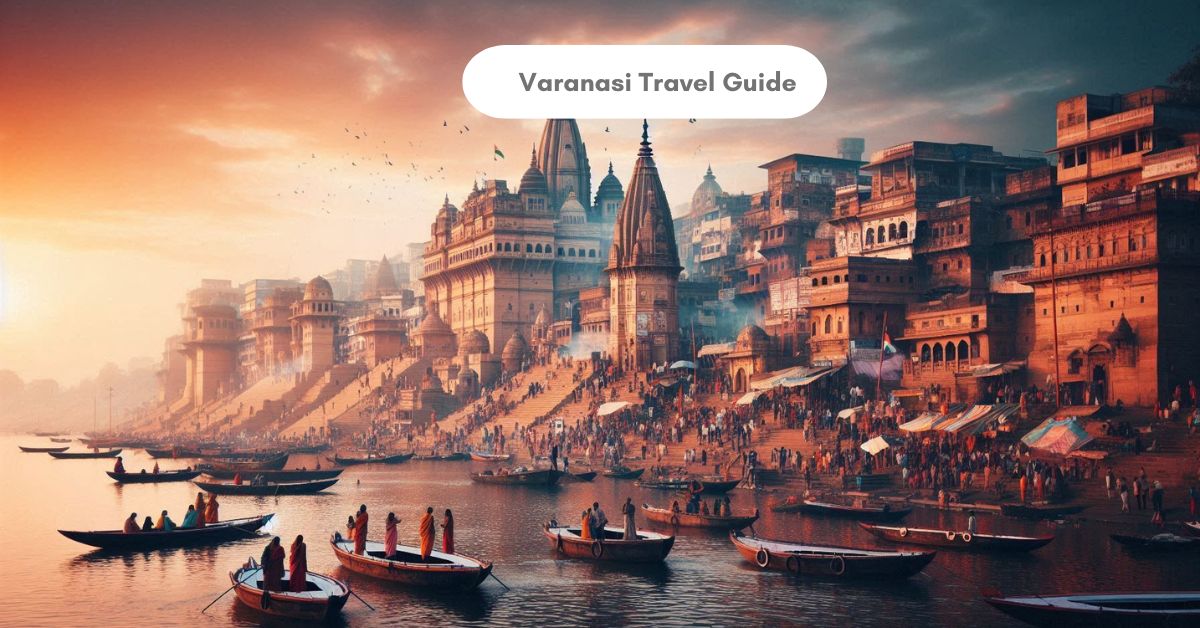Guide to Attending the Ganga Aarti in Varanasi

Guide to Attending the Ganga Aarti in Varanasi
There are some experiences in life that go beyond travel—they touch your spirit, stir your emotions, and leave you speechless. The Ganga Aarti in Varanasi is one such divine spectacle. Held daily on the ghats of the holy Ganges, this ceremony is a glowing tribute to the river goddess Ganga, one of the most sacred deities in Hinduism.
Whether you’re a spiritual seeker, a culture enthusiast, or a first-time traveler, witnessing this aarti at Dashashwamedh Ghat is a must-do experience. In this complete guide, brought to you by Tripcosmos.co, we’ll walk you through everything you need to know—from Varanasi Ganga Aarti timings to where to sit, how to prepare, and what you can expect.
1. Introduction to the Ganga Aarti Ceremony
What Is Ganga Aarti and Why Is It Performed?
The Ganga Aarti is a daily Hindu ritual dedicated to the goddess Ganga, performed on the banks of the river in Varanasi. The ceremony is a vibrant mix of fire, chant, incense, and spiritual energy that attracts thousands of devotees and tourists every evening. Its core purpose? To express gratitude and devotion to the river Ganga, which is believed to be not just a river but a living goddess.
Seven priests—trained in Vedic scriptures—perform the ritual with synchronized movements, each holding giant brass lamps and chanting mantras in unison. The sight of flames swirling in the twilight sky, with the rhythmic clang of bells and the river gently flowing in the background, is absolutely mesmerizing.
This ceremony is symbolic. Fire represents purity, the mantras invite divine blessings, and the entire aarti is a reminder of the cyclical nature of life, death, and rebirth—something Varanasi is known for.
The Cultural and Spiritual Essence of Varanasi Ganga Aarti
Beyond its religious meaning, the aarti represents Banaras’s soul. For centuries, Varanasi has been a city where the earthly and the divine intersect. Every night, this ritual reaffirms that belief, offering everyone—whether believer or not—a chance to witness India’s enduring spiritual heartbeat.
It’s not just a show. It’s a dialogue between the divine and the devotee, between light and darkness, between this life and the next.
2. Where Does the Ganga Aarti Take Place?
Dashashwamedh Ghat – The Prime Location
The main Ganga Aarti in Varanasi is performed at Dashashwamedh Ghat, which is centrally located near the Kashi Vishwanath Temple. This ghat is one of the oldest and most sacred in Varanasi. Legend says it was the spot where Lord Brahma performed a yajna and sacrificed ten horses (dasha-ashwa-medh).
Come evening, this ghat transforms. Priests dressed in saffron robes step up onto raised platforms, giant lamps are lit, and the riverbank fills with pilgrims, tourists, and locals. Whether you’re standing, sitting, or floating nearby in a boat, you’ll feel the spiritual electricity in the air.
Tripcosmos.co offers premium seating arrangements here, including VIP views and boat seating for a hassle-free and close-up experience of the ceremony.
Alternative Ghats for a More Intimate Experience
While Dashashwamedh is the most iconic, if you’re looking for a quieter, more meditative experience, consider the aarti at:
- Assi Ghat: Known for its morning Subah-e-Banaras program and evening mini aarti.
- Raja Ghat and Scindia Ghat: Occasionally host smaller, less crowded ceremonies.
These spots are great for those who wish to avoid the big crowd yet still experience the divine ambiance of the aarti.
3. Varanasi Ganga Aarti Timings and Schedule
Daily Timings (Summer vs. Winter)
Knowing the right time is key to making the most of your aarti experience. The Ganga Aarti Varanasi timings vary slightly with the seasons:
- Summer (March to October): Starts around 7:00 PM to 7:15 PM
- Winter (November to February): Starts around 6:30 PM to 6:45 PM
It lasts approximately 45 minutes to an hour, and spectators begin arriving at least an hour before the ceremony begins to grab good spots.
Tripcosmos.co offers timing alerts and pre-arranged seating to help you get the best view without the stress of jostling for space.
Special Occasions and Extended Ceremonies
During festivals like Dev Deepawali, Kartik Purnima, Makar Sankranti, and Ganga Dussehra, the aarti becomes an even grander spectacle. The entire ghat is lit with thousands of diyas (oil lamps), and additional priests often join the ritual, making it a once-in-a-lifetime experience.
These days also see higher tourist inflow, so booking in advance through Tripcosmos.co is highly recommended.
4. Best Ways to Attend the Ganga Aarti
Land Seating vs. Boat View: Pros and Cons
You can choose between attending the ceremony from the ghat steps or from a boat on the river. Here’s a quick comparison:
| Experience Type | Pros | Cons |
|---|---|---|
| Land Seating | Closer to the action, immersive atmosphere, feel the energy up close | Can be crowded, need to arrive early |
| Boat Seating | Unique angle, picturesque views, more space and privacy | Slightly removed from the sound and intensity |
Tripcosmos.co provides both options, complete with reserved seating, boat charters, and VIP passes for special days.
Booking Guided Ganga Aarti Experiences with Tripcosmos.co
To get the most out of this experience, book a guided tour. With Tripcosmos.co, you get:
- Guaranteed seating (land or boat)
- A knowledgeable local guide explaining the rituals
- Access to tea/snacks during the wait
- Optional pick-up and drop-off from your hotel
This way, you can focus on soaking in the moment while we handle the logistics.
5. What to Expect During the Aarti Ceremony
Ritual Process and Symbolism
The ceremony typically follows this sequence:
- Invocation with conch shells and Vedic mantras
- Lighting of incense sticks and oil lamps
- Circular movement of large brass lamps in rhythmic patterns
- Offering of flowers, water, and fire to the river
- Concluding with blessings and dispersal of the crowd
Each step is performed with precision and devotion, symbolizing the five elements—earth, water, fire, air, and ether. The river is honored as a goddess who sustains life, forgives sins, and delivers souls to liberation.
Sensory Experience: Sights, Sounds, and Smells
Get ready to engage all your senses:
- Sight: Golden flames, saffron robes, flower petals, floating diyas.
- Sound: Conch shells, temple bells, collective chants, harmoniums.
- Smell: Sandalwood incense, fresh marigolds, ghee lamps.
Many travelers report feeling goosebumps, even tears, during the ceremony. It’s an emotional and unforgettable experience.
6. How to Reach Dashashwamedh Ghat
Located at the center of the spiritual and cultural life of the city, Dashashwamedh Ghat is easily accessible—but because of the dense alleys and pedestrian-only areas around it, reaching the ghat might need a bit of planning.
If you’re staying in the old city or near Godowlia Chowk, you can simply walk down to the ghat. The narrow winding lanes—called galis—are an adventure in themselves, lined with sweet shops, temples, and local bazaars.
Coming from outside? Here are the best routes:
- By Auto Rickshaw or E-Rickshaw: These can take you as close as Godowlia Crossing, from where it’s a short 10-minute walk to the ghat.
- By Taxi: Not ideal for getting too close due to road restrictions near the ghats, but taxis can drop you off at Godowlia or Bansphatak.
- By Boat: If you’re staying at a riverside hotel or coming from another ghat, you can simply hire a river boat and arrive directly at Dashashwamedh Ghat for a grand entry.
Tripcosmos.co provides pick-up and drop-off services as part of its Ganga Aarti packages, ensuring stress-free navigation even during peak hours or festive seasons.
7. Best Time of Year to Attend the Ganga Aarti
Seasonal Charm and Festival Magic
While the Ganga Aarti is held every evening, year-round, some months offer a more comfortable and festive experience than others.
Ideal Months: October to March
These cooler months provide pleasant weather and align with major Hindu festivals like:
- Kartik Purnima
- Dev Deepawali
- Makar Sankranti
During these festivals, the ghats are adorned with countless diyas, and the city glows with devotion. The air is crisp, and the river shimmers in the golden glow of lamps and fireworks—pure magic!
Avoidable Period: Peak Summer (April to June)
Temperatures can soar above 40°C, making it uncomfortable for prolonged outdoor stays, especially in crowded places like Dashashwamedh Ghat.
Monsoon (July to September)
While less crowded, the water levels rise and some ghats may be partially submerged or slippery. However, aarti still continues—just with minor adjustments.
Tripcosmos.co recommends planning your aarti experience during winter for the most enchanting ambiance and smoother logistics.
8. What to Wear and Carry When Attending the Aarti
Dress Modestly, Pack Smartly
Attending a Ganga Aarti, especially at a spiritual epicenter like Varanasi, requires a blend of respect and practicality. Here’s what you should keep in mind:
For Men and Women:
- Opt for loose-fitting cotton clothes—comfortable and culturally appropriate.
- Avoid shorts, sleeveless tops, or revealing outfits, especially if you plan to visit temples afterward.
- In winter, carry a light shawl or sweater as evenings can get chilly by the riverside.
Essentials to Carry:
- Reusable water bottle
- Camera/Phone with good low-light capability (but respect “no photography” zones)
- Small mat or scarf to sit on if you’re choosing steps over paid seating
- Cash in small denominations for offerings, snacks, or boat tips
Tripcosmos.co also provides essentials kits for guests booking premium Aarti packages—including mats, mineral water, and biodegradable flower offerings.
9. Etiquette Tips for First-Time Attendees
Be Present, Be Respectful
While the Ganga Aarti is visually spectacular, it is first and foremost a religious ceremony, not a tourist show. Respectful behavior ensures that everyone—devotee or visitor—can appreciate its sanctity.
Dos:
- Arrive early: This shows respect and ensures a good spot.
- Stand up when the aarti begins, especially during major moments like bell ringing and final fire rotations.
- Participate silently: Fold your hands in a prayer pose if you’re unsure what to do.
Don’ts:
- Don’t block others’ view by standing or filming continuously.
- Don’t take selfies during the ceremony—this breaks the spiritual rhythm for others.
- Avoid smoking, littering, or speaking loudly during the rituals.
Tripcosmos.co guides provide gentle instructions and cultural context before the ceremony, especially helpful for international guests or those unfamiliar with Hindu rituals.
10. Enhance Your Ganga Aarti Experience with Tripcosmos.co
Let Experts Make It Seamless and Sacred
Whether you want a peaceful riverside view, close-up priest interaction, or an unforgettable spiritual photography tour, Tripcosmos.co ensures you get the best of Ganga Aarti with zero stress.
Why Choose Tripcosmos.co?
- Locally operated in Varanasi with years of experience.
- Offers customizable aarti packages including:
- Guided walking tours through the ghats and temples
- Private or shared boat rides
- VIP seating and spiritual commentary
- Great for solo travelers, couples, families, and spiritual groups
Add-Ons Available:
- Puja offerings with your name
- Diyas for floating prayers
- Photography and videography services
- Combined Ganga Aarti and food walk tours
One Last Tip: Book early if you’re traveling during weekends or festivals. Slots fill quickly, and experiencing the Ganga Aarti with the right guide and setup can turn a spiritual evening into a lifetime memory.
Conclusion: The Ganga Aarti – More Than a Ceremony
Attending the Ganga Aarti at Dashashwamedh Ghat isn’t just an evening activity—it’s a sacred doorway into the ancient soul of India. As the lamps glow, the mantras echo, and the river sparkles in divine rhythm, you’ll find yourself swept into a spiritual current that transcends religion, time, and even thought.
With the right preparation, guidance, and open heart, this one hour by the river can become the most unforgettable part of your journey to Varanasi. Let Tripcosmos.co help you unlock the full experience—safe, seamless, and soulful.
FAQs
1. What time should I arrive to get a good spot for the Ganga Aarti?
Aim to reach Dashashwamedh Ghat at least 45 minutes to an hour before the ceremony begins, especially if you don’t have a reserved seat or boat.
2. Is there a morning Ganga Aarti in Varanasi?
Yes, Assi Ghat hosts a beautiful morning version called Subah-e-Banaras, starting around 5:00 AM—a mix of yoga, music, and spiritual ritual.
3. Can foreigners participate in the rituals during the aarti?
While active participation (like handling lamps) is reserved for priests, guests can offer flowers, float diyas, and receive blessings—guided experiences from Tripcosmos.co include this respectfully.
4. Are kids allowed to attend the Ganga Aarti?
Yes! Children are welcome but should be supervised due to large crowds and open flames. Early arrival and seating are recommended for family groups.
5. What happens if it rains during the Aarti?
The aarti continues unless there’s extreme weather. In light rain, it’s often moved slightly under shelter, but the devotion never stops.




